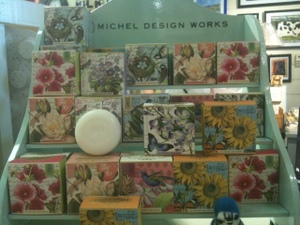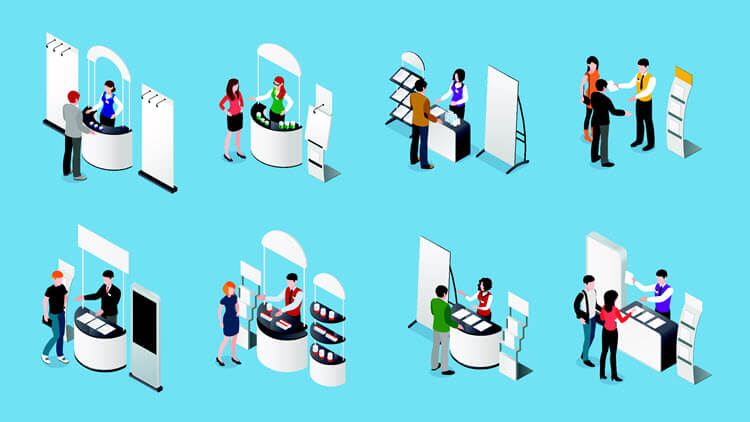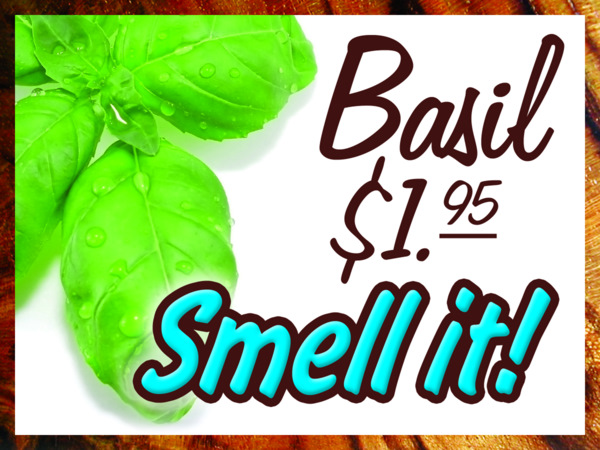There is nothing more you could do to add power and punch to your merchandising scheme for increasing sales than to use a point of purchase (POP) display. I can guarantee that using this merchandising method will increase your sales, for retail and particularly for wholesale. The POP is an unpaid and silent salesperson that gets your customers to notice your products. A well-designed display and engaging graphics will tell your story and help give you brand recognition better than any method I know. Plus, customers will buy more when they buy from a POP. This is particularly true with items that need to be explained or demonstrated for the customers to “get it!” Point of purchase displays are not right for all types of merchandise. But, generally, lower-end items, such as cards, soap, mugs, and toys, will fly out of your booth or the stores you sell to.
A point of purchase display can be very simple. There are many commercially available displays that might suit your purposes for fast and easy uses. If you Google “point of purchase displays,” you will find 2,054 sites that match your search. Most of these suppliers will have merchandise that’s too commercial-looking for handmade artistic merchandise, but, with a critical eye, you might find just what you need. A thorough search will also reveal the Thompson list of display suppliers, many of which offer standard point of purchase displays for a variety of merchandise.
Having a POP display custom-made will be more costly and involved, but such a display, if well-executed, will really make your merchandise stand out from the competition. If you make greeting cards, for example, the POP would most likely be a wire card rack that would hold 12, 24, 36, or 48 cards. Smaller racks can be either floor or table models. These are quite simple and easy to acquire. If you Google “wire card racks,” you will find dozens of suppliers all over the country who supply these merchandising devices. A 24-pocket rack generally will cost around $48, plus shipping; prices drop when purchased in quantity.
Nancie Dunn Cards www.nanciedunncards.com finds that stores that use a branded POP card rack sell 25 to 40 percent more cards than stores that don’t use a branded POP rack. That is a huge growth in sales for such a small expenditure, and the lifetime of that rack could be many years. For this reason, it is really important to get wholesale customers to realize the importance of purchasing a rack. So important, in fact, that many businesses that use POP displays offer the display to their customers at no charge, knowing that, in the long run, the display will pay for itself many times over. Standard practice at gift shows, when a customer is placing an order, is for the salesperson to offer the display at cost, say $48. Then, further incentive to get the customer to order is to “offset” the cost of the display with $24 of free merchandise to fill the display. That is usually enough incentive to get a customer to purchase the display.
The display works for the artists in several ways. For starters, it gets the retail customer to notice the product and take a closer look, particularly if the graphics and the style of the display are clever and work well with the product line. A line of sterling silver honey bee jewelry gets noticed, for example, when the POP is in the shape of a bee hive. A display such as this attracts attention to the product and gives the customer valuable information about the product and how to use it. This example illustrates how a person can get a story out there and not take up a lot of space in a booth or in a store. This is where the silent and unpaid salesperson comes in; the display is actually telling the customer valuable information, the story of the work. What the product is used for, what it means, and its multiple uses can be explained on the POP. All of these opportunities work for both wholesale and retail selling. If you do only retail shows, you will be amazed at how a POP display will sell for you when you are busy talking to other customers. Many times, when you look up from one transaction, there is another customer standing in front of you with the product in her hands ready to buy, and you didn’t have to say a word; the display did all the work for you.
 POP displays really show their might on the wholesale level. When a display starts to have empty spots, meaning the inventory was sold, it sends a signal to the buyer that it is time to reorder. Reordering and restocking are really where a point of purchase display shows its muscle. Customers tend to order larger quantities and more frequently when the display starts to get low or empty. This is particularly true with lower-cost items, such as soap, cards, or low-end jewelry. When a store or gallery sells an expensive item, they take notice. But, lower-end items in the $10-$20 range sell all the time, with little attention paid to reordering these items, compared to items in the higher-end price point. Many times, lower-end items are completely sold through in a store, and the line is forgotten. The point of purchase display levels the playing field between high-end and low-end merchandise.
POP displays really show their might on the wholesale level. When a display starts to have empty spots, meaning the inventory was sold, it sends a signal to the buyer that it is time to reorder. Reordering and restocking are really where a point of purchase display shows its muscle. Customers tend to order larger quantities and more frequently when the display starts to get low or empty. This is particularly true with lower-cost items, such as soap, cards, or low-end jewelry. When a store or gallery sells an expensive item, they take notice. But, lower-end items in the $10-$20 range sell all the time, with little attention paid to reordering these items, compared to items in the higher-end price point. Many times, lower-end items are completely sold through in a store, and the line is forgotten. The point of purchase display levels the playing field between high-end and low-end merchandise.
Another fine feature of a POP is that it builds a brand for your products. When a customer who has purchased your products at one location sees your POP at another location, an immediate connection is made. Customers are familiar with the brand; it makes them look more closely and perhaps purchase again or encourage someone else to buy from your display.
If you wholesale your work, you will find that the point of purchase display not only will sell more products to retail customers, but it also will make your phone ring more often. You will hear that a store owner who saw your display in one store wants to bring your line into his store. Keep in mind that when merchants travel for business or go on vacation, a big part of what they do is check out other stores in other areas. Lone products on the shelves do not have the brand allure that a well-designed POP has.
Now that you are aware of the power of the POP, look at all the different types of these displays the next time you go shopping. Analyze what makes one work over another. Would a cardboard or basket display work for your product line or would a wooden or metal display be better to tell your story? For sure, a POP will power-boost your sales. If you wholesale your work, it will get you faster and larger reorders.






